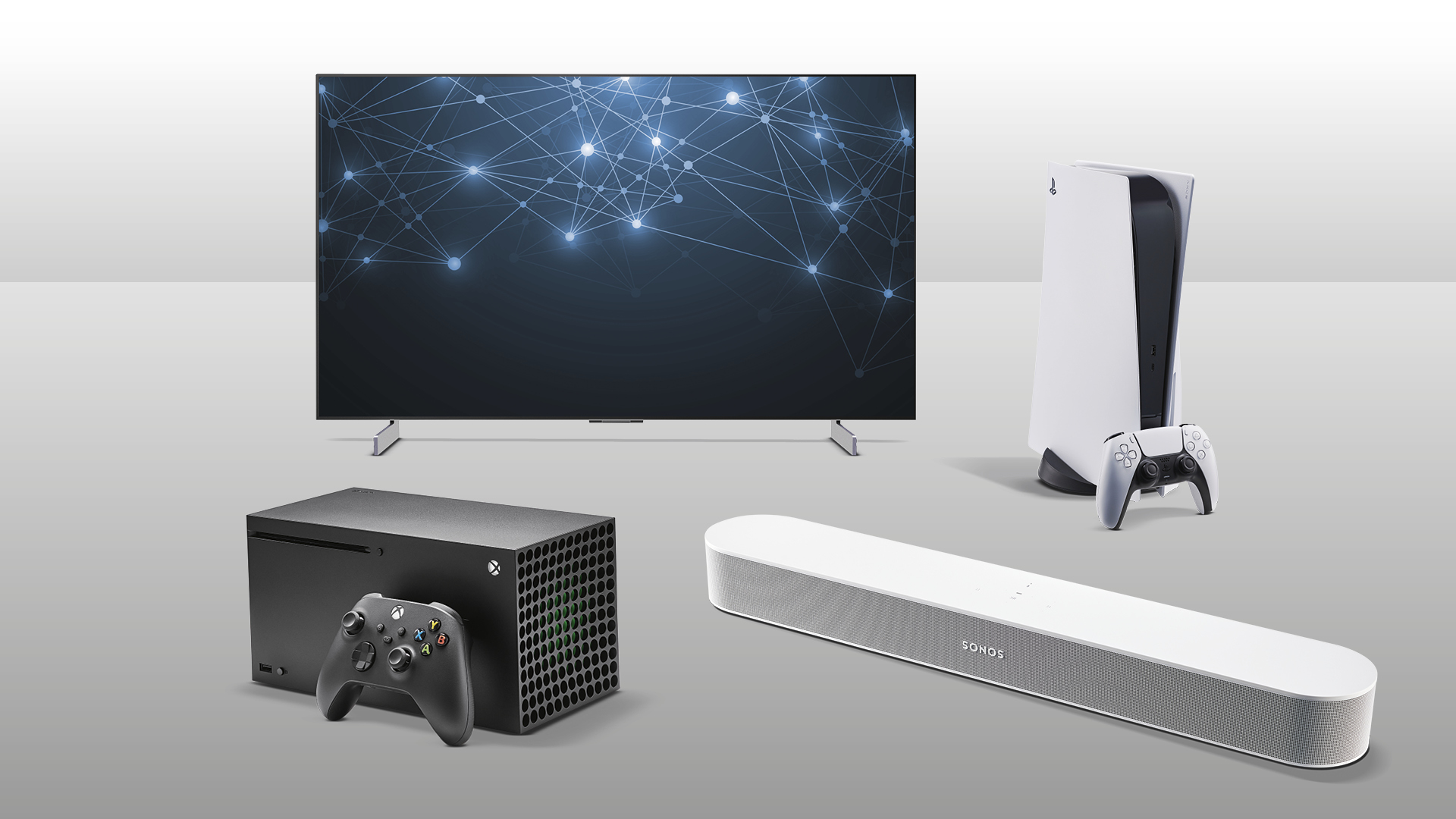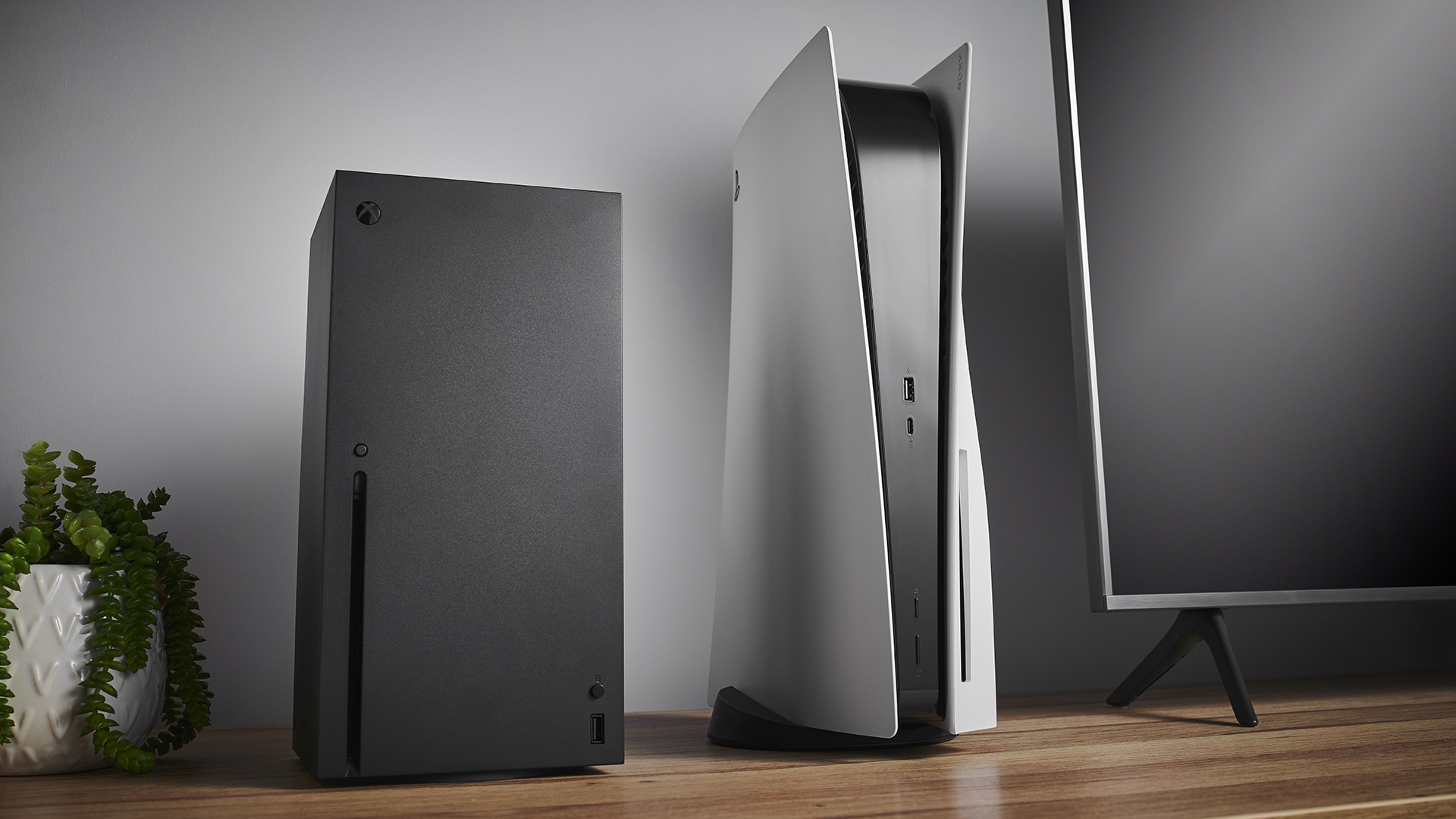This compact, OLED-enhanced gaming system will keep you entertained for years
We've combined both current-gen consoles with a 42-inch OLED TV and a small Dolby Atmos soundbar

We don’t imagine there are too many of you out there who will be buying a TV system exclusively to indulge your passion for FC 24 or the latest incarnation of CoD; for most buyers, a good gaming system needs to shine with TV and movies as well as competitive pastimes.
Nevertheless, there are one or two key strengths that a good gaming system simply must possess – which is why we have chosen this particular quartet to kick off our selection of top AV systems.
The system
- TV: LG OLED42C3 (£999 / $900 / AU$1695)
- Soundbar: Sonos Beam Gen 2 (£499 / $499 / AU$629)
- Console 1: Sony PlayStation 5 (£459 / $500 / AU$799)
- Console 2: Xbox Series X (£379 / $420 / AU$649)
- Total system price: £2336 / $2319 / AU$3772
TV: LG OLED42C3

Let’s start with that most important ingredient of all – the TV. While LG has this year made much of its G3 range – the world’s first MLA OLED screen – the C3 has quietly bagged our 2023 Award for the Best 40-43in TV, not least because it is terrific value for money. Its retail price alone should turn heads but recent healthy discounts have made it a real prize.
Crucial for a serious gaming TV, the LG has four HDMI 2.1 sockets, all rated to the full bandwidth of 48Gbps, and all capable of handling the 4K/120Hz, VRR and ALLM signals that are output by its console partners here, the PS5 and Xbox Series X. Plenty of tellies can handle these gaming features, but most can only do so via two HDMI sockets, one of which often has to fulfil eARC output duties.
The real headline here is that LG’s TVs combine this array of four HDMI 2.1 sockets with support for Dolby Vision gaming at up to 4K/120Hz, which is still a real rarity in the TV world and is great for Xbox Series X gamers. The C3 also includes a particularly good execution of HGiG, an agreed industry standard for the implementation of HDR in gaming. This essentially makes it easy to get good tone mapping in many modern games.
Fulfilling our brief to also excel with TV and movies, the C3’s operating system is crammed full of content, all of it easy to access and smooth-functioning. You couldn’t reasonably wish for a broader spread of streaming apps, and all the content that should be presented in 4K, Dolby Vision or Dolby Atmos, is.
The LG might seem small against many of today’s leading screens, but this gives it the advantage of a higher pixel density, and that means pin-sharp images. In fact, the OLED42C3’s picture delivery actually makes its 65-inch sibling look a touch hazy. In addition, this TV’s image presentation is wonderfully dynamic and punchy, as well as being particularly subtle and natural with colours; all of which helps make games seem more realistic and immersive. Just remember to adjust the motion processing to your taste though – this is one area where LG still can’t quite match Sony’s mastery. Our recommendation would be to start with the Cinematic Movement option and compare that with the other processing options available.
Get the What Hi-Fi? Newsletter
The latest hi-fi, home cinema and tech news, reviews, buying advice and deals, direct to your inbox.
We can’t pretend this 42-inch version of the C3 delivers much to get excited about when it comes to sound, but that couldn’t matter less in this context, as the excellent Sonos Beam (Gen 2) is on hand to take the sonic reins.
Soundbar: Sonos Beam (Gen 2)

When it comes to breaking into the big time, Sonos cracked the sound barrier long ago. Where it has really excelled though, is in keeping its product line fresh with constant updates and new models. And the Beam (Gen 2) is a good example. We liked it enough to say, in our original review, that “While sequels often pale in comparison to their predecessors, the Sonos Beam Gen 2 joins the ranks of The Dark Knight, The Godfather Part II and The Empire Strikes Back as not only a worthy successor but better than its predecessor in every way. That's no small claim, as the first-generation Beam captured our hearts back in 2018 and was adorned with What Hi-Fi? Awards up until this new version launched.”
And we haven’t changed our minds. Key to the Beam’s success is the inclusion of Dolby Atmos, and it really is quite a revelation – despite not having any dedicated upward-firing speakers among its roster of five drivers. Genuinely located overhead sounds are, admittedly, slightly out of the Beam’s reach, but there is more to Dolby Atmos than aeroplanes and helicopters, and the Gen 2 handles this format better than any other comparably priced soundbar. We would even go as far as saying that the Beam does a better job with it than many more expensive soundbars with upward-facing drivers.
When listening to Atmos films with the Beam Gen 2 there's tangible motion, depth and space, which heightens the drama and sense of immersion. And, of course, that same sense of drama is present when you are gaming, as the Beam’s skill with space and dynamics comes to the fore to render effects with punch and accuracy.
Not many soundbars at this price point come with networking capabilities, but the Beam Gen 2’s ability to integrate into a wireless multiroom system – as you would expect from a Sonos product – is fundamental to its design. Although you can control the volume via your TV remote, you will need the slick and user-friendly Sonos S2 app to connect the Beam to other Sonos products.
Housed at the rear in the ‘cable cove’ are sockets for power, ethernet and HDMI eARC as well as a connect/reset push button, while the top surface carries touch-sensitive buttons, LEDs and mics for voice control of Amazon Alexa and Google Assistant. Spotify Connect is built in as well.
Consoles: Sony PS5 and Xbox Series X

And so to the console. Or, rather, consoles. Anyone who knows the first thing about gaming also knows that there are only really two players in this game; Sony’s PlayStation, currently in its fifth iteration, and the Microsoft Xbox, here in its latest, flagship Series X guise. And anyone serious enough about gaming to build an AV system around it will know that, with many titles only available on one or the other of the two devices, the only way to be sure you can access the games that you want is to have both models at your disposal.
Both are available without an optical disc-drive, but in each case we feel the compromises are not worth the cash saving, and so are including the full-fat versions here.
Measuring 39 x 10 x 26cm, the PS5 is huge – so big that it makes the Xbox Series X (which itself has considerable bulk) look positively compact. As long as you’ve got space for it though, any worries about its size will surely vanish once you start using its satisfyingly responsive DualSense controller. It’s a massive step up from its DualShock predecessor, and is packed with technology that helps immerse you in the games you play in new and inventive ways, including by providing haptic feedback as well as resistance in the triggers.
Being older tech, the Xbox’s controller can’t match that level of sophistication, but it is still a hugely capable device, helped by effective Dynamic Latency Input (DLI) that is designed to immediately synchronise each controller input with what you see on your screen.
Both the PS5 and Xbox have 8-core CPUs from AMD, but the Xbox’s are clocked at 3.8GHz while the PS5’s are 3.5GHz. Both consoles also use AMD graphics processors, the Xbox’s providing 12 teraflops of power against the PS5’s 10.28 teraflops.
Both consoles offer plenty of streaming apps, from Netflix and Amazon Prime Video, to Apple TV, Disney+ and YouTube. In the UK, both launched without BBC iPlayer, although Microsoft soon brought it to the Xbox consoles and Sony followed suit.
When it comes down to gaming performance, both consoles deliver a super-solid 4K/60Hz experience and some games are available in even more responsive 4K/120Hz. VRR and ALLM are supported by both consoles, too, and the Xbox supports gaming in Dolby Vision as well as the standard HDR10 offered by the PS5.
In performance terms, there's very little between the PS5 and XSX, so if you are choosing between the two it makes the most sense to go for the one that your friends already own so that you can play together online.
The respective game subscription services should be considered too, though, and here the Xbox Series X comes out on top: Xbox Game Pass is an extraordinarily good deal that gives you access to every first-party Xbox game (even those that are brand new) and loads of third-party games for a very reasonable monthly cost. PlayStation's equivalent, PS Plus Extra, is similar but less overflowing with games and doesn't grant access to first-party blockbusters until they have been out for a while.
Of course, a really serious gamer will want to cover all of the bases, which is why we have included both consoles in this dedicated gaming system. There's an option to add a Nintendo Switch or gaming PC via the last remaining HDMI socket, too...
What Hi-Fi?, founded in 1976, is the world's leading independent guide to buying and owning hi-fi and home entertainment products. Our comprehensive tests help you buy the very best for your money, with our advice sections giving you step-by-step information on how to get even more from your music and movies. Everything is tested by our dedicated team of in-house reviewers in our custom-built test rooms in London, Reading and Bath. Our coveted five-star rating and Awards are recognised all over the world as the ultimate seal of approval, so you can buy with absolute confidence.

